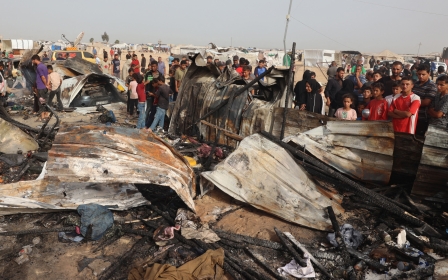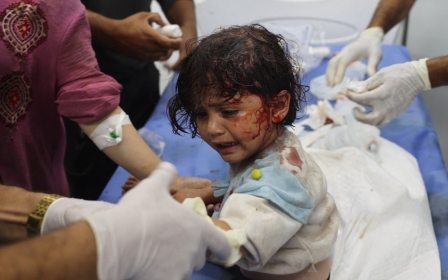The mutilation of Palestine has been a strategy of Israel since its inception

"Mutilation" means to severely cut off one part of the body from the rest, to disintegrate a part from the whole, but also to leave a mark of violence on the whole, where every look at the mutilated body invokes the memory of violence and inspires terror.
Mutilation also impacts the perception or purpose of the body: if a book has been cut through using scissors, it remains a book, and yet it cannot be read in the same way prior to mutilation. Perhaps the intention of mutilating a book is precisely so that it cannot be read.
The history of mutilation, therefore, is the history of suffering and the experience of violence that intends to change the existence of the object/subject.
Israel is an ethnonational state, or what I call a carceralopolis, which privileges the Jewish citizens of the state based on fictive ethnic roots, and grants them extraordinary carceral control over native Palestinians.
New MEE newsletter: Jerusalem Dispatch
Sign up to get the latest insights and analysis on Israel-Palestine, alongside Turkey Unpacked and other MEE newsletters
Since October 2023, the military assault against Gaza and its inhabitants has revealed another strategy that the Zionists have long had: the mutilation of Palestine, which dates back to the early 20th century.
Types of mutilation
In the context of Palestine, "mutilation" holds multiple semantic connotations. Mutilation was cartographic, as the land was torn apart in 1948 and split into the territories of Israel, with the West Bank, Gaza, and East Jerusalem being externally occupied.
The mutilation was also historical, as post-1967 West Bank and Gaza had schizophrenic dis/similarities. Their histories evolved through checkpoints and sieges, respectively, and yet the Palestinians here were forced to live separate and almost unconnected lives.
The ethnonational state maintained control over Palestinians with the sole aim of racial domination, irrespective of territory
At the same time, the ethnonational state maintained control over Palestinians with the sole aim of racial domination, irrespective of territory.
The mutilation continued with the Israeli annexation and occupation of the three territories in 1967. Mutilation was rhetorical, with then-Prime Minister Golda Meir claiming in 1969 that "there was no such thing as Palestinians", which aimed to delegitimise Palestinian history and existence on the land.
The 700,000 Palestinians who had been displaced were called "present absentees" so that the Jewish National Fund could acquire their houses.
Mutilation was topographical, for the ethnonational state uprooted native olive trees to plant pine trees that mimic a more European landscape; it replaced Arabic names of towns with Hebrew ones; it dissected Palestinian farmlands through a snaking separation wall in the West Bank; and segregated roads for Israeli and Palestinian use.
Trauma of mutilation
Ethnic Studies scholar Jasbir K Puar observes that Israel has traditionally held the "right to maim" Palestinians, arguing that the ethnonational state possesses powers beyond what the French philosopher Michel Foucault conceptualised as the "biopolitical" power of the state, or in other words, deciding who gets to live or die.
Mutilation enables the ethnonational state to partially destroy, incapacitate and retain the power of the one who remedies.
Follow Middle East Eye's live coverage of the Israel-Palestine war
In "Sleep it Off, Dr Schott", a short story in Bhasma Galyani's 2019 collection of dystopic science fiction, Palestine +100, writer Selma Dabbagh imagines the Gaza of 2034. The narrator, Layla Wattan, is a resident of Gaza and confesses to spying on an inspirational scientist, Mona Kamal, who created 3D-printed limbs for disabled people and built a robotic army.
The narrator agrees to spy on Kamal to get a job at the scientific enclave, implying that Gaza in the future is still reeling from economic devastation. Through narrative techniques, the effects of mutilation are converted into empowering scientific experiments yet carry the deep trauma of loss.
Akram Musallam's experimental novel, The Dance of the Deep Blue Scorpion, describes the mutilation of Palestinian life under Israeli occupation. The narrator describes being haunted by his father's loss of a limb after stepping on a nail in 1967, along with the loss of his family's home and land. His father feels an itch in the phantom limb despite his leg's amputation.
While there is a medical and neurological explanation for feeling pain in a limb that no longer exists, how do we characterise the suffering that emerges from the loss of a home and the mutilation of a homeland?
Trauma from mutilation is the new prisonhouse of the Israeli carceralopolis.
'Total annihilation'
Rita Sakr, a scholar of postcolonial and global literatures, observes that physical dismemberment forced writers like Atef Abu Saif, who wrote The Drone Eats With Me: A Gaza Diary, to invent a new narrative form combining testimony, prose-poetic war memoir, and socio-political study.
Mutilation forced Abu Saif to invent what I call an "inverted metonymy". As opposed to metonymy, where a part refers to a whole, here, the whole disintegrates to give meaning to parts. The exploding buildings are synonymous with Palestinian bodies, and narratives are used for literary invention when the reality is too horrible to bear the weight of trauma.
The genocide of Palestinians since October 2023 has made the ongoing mutilation of Palestinian society painfully apparent to new generations of youth, students, and workers of the world.
In a disproportionate retaliation to Hamas's 7 October offensive, Israel began the mutilation and dismemberment of Gaza and its citizens. The present condition of Palestinians is numerically and ethically worse than the Nakba of 1948.
Over 1.2 million Palestinians have been displaced multiple times, and more than 36,000 have been killed, of which 15,000 are children. This does not include the estimated thousands who lay under the rubble of Gaza. Over 80,000 Palestinians have been injured, including more than 12,000 children.
In January, Save the Children reported that more than 10 Palestinian children a day, on average, are losing their limbs - one or both legs - during Israel's war on Gaza.
Despite being accused of war crimes by the International Court of Justice and asked to enforce a ceasefire, the ethnonational state operates with the agenda behind mutilation: total annihilation.
The mutilation has been deliberately targeted at infrastructure, which started with the bombing of northern Gaza, implying there would be "free" land on which Zionists could live and even play games like Monopoly to imagine building their empire.
Al-Shifa Hospital, its doctors, medical staff and patients were bombed, ensuring that Palestinians do not have the means to recover, and the structurally decimated building cannot be used for shelter.
Mutilation has also been targeted at knowledge bases and archives, with the bombing of schools, universities, and museums, disabling knowledge production through the burning of archives and books. Mutilation is also strategic as different kinds of explosives are used to kill starving Palestinians who are drawn out by drones that play the sounds of women and children in distress.
Humiliation was an evident precursor of mutilation when over 400 Palestinians were found in mass graves wearing zip ties, their bodies showing signs of torture and execution.
Palestinians have been forced to flee or confine in the southernmost town of Rafah, where on 26 May, Israeli explosives set plastic tents on fire. Witnesses and survivors shared videos of mutilated babies and their burnt parents.
As the world is horrified, we can only ask: what will it take to end this mutilation of Palestine and Palestinians?
The views expressed in this article belong to the author and do not necessarily reflect the editorial policy of Middle East Eye.
Middle East Eye delivers independent and unrivalled coverage and analysis of the Middle East, North Africa and beyond. To learn more about republishing this content and the associated fees, please fill out this form. More about MEE can be found here.





